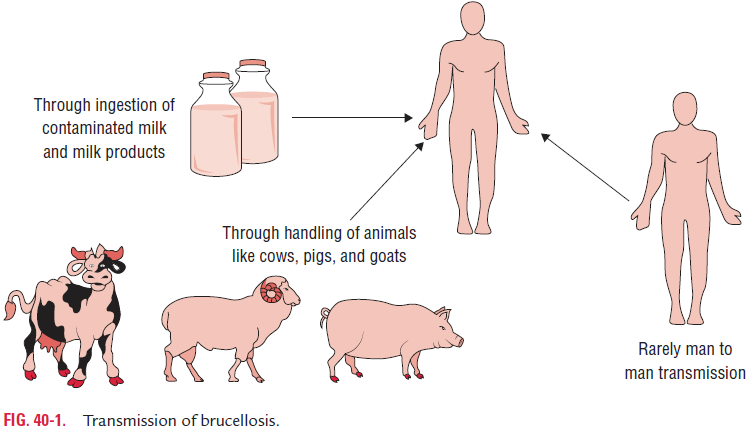Chapter: Microbiology and Immunology: Bacteriology: Brucella
Epidemiology - Brucella
Epidemiology
◗ Geographical distribution
Brucella infection is worldwide in distribution. The conditionis endemic in certain Mediterranean countries. More than 500,000 cases of brucellosis are reported annually. Different Brucella species cause human infection in different geographicalareas. B. melitensis is the major species causing human infection in India. In the United States, B. suis is the major species respon-sible for infection, whereas in Great Britain, B. abortus is the important species responsible for infection.
◗ Habitat
Brucella species are primarily obligate intracellular pathogensof the reticuloendothelial system, such as lymph nodes, liver, spleen, and bone marrow.
◗ Reservoir, source, and transmission of infection
Brucella species cause infection in a wide range of hosts, butthese species show a high degree of host specificity. B. meliten-sis infects goats and sheep; B. abortus, cattle; B. suis, swines; and B. canis, dogs and foxes. The infected animals, such as cattle,goats, sheep, buffalos, and swine are the important reservoirs of infections.
The incidence of human disease is very closely related to the prevalence of infections in cattle, goats, and sheep. This is also related to activities that allow exposure of humans to poten-tially infected animals or their products.
Human brucellosis is primarily a zoonotic bacterial infection. The infection is acquired always from animals directly or indirectly.Brucella organism is transmitted to humans by the following ways (Fig. 40-1): (a) ingestion, (b) direct contact, (c) inhalation, and (d) accidental inoculation.

1. Ingestion: Brucellosis results primarily by drinking con-taminated unpasteurized milk or milk products. The infec-tion can also be transmitted by drinking water or eating raw vegetables contaminated with feces or urine of infected animals and also by eating meat of infected animals.
2.Direct contact: The infection is acquired by direct contactwith the infected materials of septic abortion of the animals or at the time of slaughter of animals. Brucella species present in the infected materials (placenta, fetuses, vaginal discharge, urine, or infected carcasses) enter the human host through the mucosa, conjunctiva, or skin.
3. Inhalation: The infection is transmitted by inhalation ofdust from wool or other dried material of infected animals. Infection by inhalation is important among veterinarians and laboratory workers.
4. Accidental inoculation: Accidental inoculation is a seriousrisk in laboratory workers who handle culture of the organism. The incidence of infection in laboratory workers is reported in the countries of the Middle East and also in the United States, China, Peru, Mexico, and India.
Related Topics